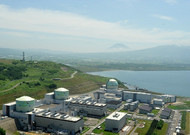Japan May Be Atomic-Power Free Next Month After Shutdown
 Japan may be without atomic- generated electricity for the first time in more than four decades next month when its last reactor still running after the Fukushima nuclear disaster shuts for maintenance.
Japan may be without atomic- generated electricity for the first time in more than four decades next month when its last reactor still running after the Fukushima nuclear disaster shuts for maintenance. Since the crisis on March 11 last year, 53 of Japan’s 54 reactors have been shut either owing to damage from the earthquake and tsunami, government order, or mandatory maintenance. The plants provided 30 percent of the country’s electricity prior to March 11. The last one running on the northern island of Hokkaido goes offline from May 5.
Japan may “momentarily” be without atomic power from that date, the Mainichi newspaper cited Industry Minister Yukio Edano as saying on April 15 after he spent the weekend in western Japan and failed to get immediate agreement from local authorities that reactors run by Kansai Electric Power Co.in Fukui prefecture passed safety tests and should restart.
“Whether or not we can restart the reactors depends on future discussions,” he said at a Tokyo news conference yesterday.
The utilities powering the world’s third biggest economy have been forced to turn to coal, oil and gas-fired power plants to keep factories, offices and households supplied with electricity. Buying and importing those fuels is driving up costs and may lead to higher electricity bills and another drag on an economy that’s contracted in three of the last four years.
“Ultimately, the Japanese citizen will be most affected by the delay in the restarts in paying higher electricity bills,” said Tomoko Murakami, a Tokyo-based nuclear analyst at the Institute of Energy Economics, Japan.
Japan’s 10 regional power utilities bought record amounts of liquefied natural gas last year to replace nuclear, or 52.9 million metric tons of LNG in the fiscal year ended in March, up 27 percent from the prior year, according to data yesterday from the Federation of Electric Power Companies.
Use of petroleum, which includes crude and fuel oil, more than doubled to 23.3 million kiloliters (147 million barrels), according to the federation’s data. Petroleum consumption was the highest in at least 10 years.
Fuel costs at the nine regional utilities that have atomic plants (Okinawa Electric Power Co. is the exception) may more than double to about 7 trillion yen ($86.5 billion) in the year ending March 2013 if reactors remain shut, according to an April 9 report by the trade and industry ministry. Kansai Electric’s fuel bills may rise by 800 billion yen to about 1.1 trillion yen, it said.
The country will have no reactor in operation for the first time since May 1970 if Hokkaido Electric Power Co’s Tomari No. 3 reactor is taken offline before Kansai Electric starts two reactors at its Ohi plant in Fukui, said Tetsu Oshikiri, a spokesman for the Federation of Electric Power Companies of Japan, in Tokyo yesterday.
Tomoe Sugimori, a spokeswoman for Kansai Electric Power said it usually take about 10 days to start an idled reactor . That means local lawmakers would need to approve a restart by April 25 for the Ohi reactors to be online before the Tomari unit shuts.
“We can’t set a deadline on when the government can get the cooperation of local governments on the restarts,” Chief Cabinet Secretary Osamu Fujimura said at a news conference in Tokyo yesterday.
The Ohi atomic plant is located about 95 kilometers (59 miles) northeast of Osaka, the nation’s second-biggest metropolitan area. It help power the Kansai area of western Japan that’s about the size of Belgium, has an economy worth $1 trillion – similar in size to Mexico’s – and is home to the cities of Osaka and Kyoto as well as factories of Sharp Corp. and Panasonic Corp.
Kansai Electric’s output without nuclear power may be 18.4 percent short of peak demand this summer if Japan is hit by a heat wave similar to the one in 2010, the national government said in a statement April 13, revising down its April 9 forecast of 19.6 percent.
The utility would need to turn on half of its 11 reactors to avoid the summer power shortages forecast under the government’s worst case scenario, Murakami at Energy Economics said. Restarting that number of reactors is very unlikely, she said.
The governor of Shiga prefecture adjoining Fukui criticized the government for what she called the “rush to restart the reactors” in an April 11 interview. The government’s earlier power shortage forecast was flawed as it was based on Japan’s hottest summer in at least 113 years and ignored power savings and private electricity generation capacity, Shiga Governor Yukiko Kada said.
Kada and the governor of Kyoto prefecture, also adjoining Fukui, held a joint press conference today and said an independent body should assess electricity supply and demand, Kyodo News reported.
The government has already decided to do that and will set power saving targets once the independent review is complete, cabinet secretary Fujimura said yesterday.
You can return to the main Market News page, or press the Back button on your browser.

